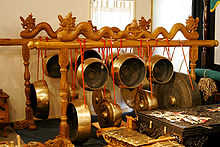Balinese music
Balinese music is the music of the island of Bali, which belongs to Indonesia . Most of the Balinese music is instrumental and is performed with an ensemble called gamelan , which is comparable to the larger neighboring island of Java . In the pre-Islamic period, shaped by Buddhism and Hinduism , some musical forms were introduced from East Java to Bali. From the 17th century onwards, Balinese music developed largely independently.
One vocal style is the monkey-imitating choir singing in the Kecak dance. Frogs are musically imitated with the jaw harp genggong .
Balinese instruments are metallophones with bronze plates gangsa , bamboo xylophones , gongs , the gong circle trompong as well as a variety of drums and rattles like the angklung . There are different sizes of bamboo flutes ( suling ), the two-stringed spiked fiddle rebab and the bamboo tube zither guntang .
Gambuh is considered the most traditional style. A form of gamelan developed in the 20th century is the gamelan gong kebyar , an energetic style, the latest variant of which is called kreasi baru ("new creation"). Some Balinese musical styles are also cultivated in the music of Lombok .
literature
- Lisa Gold: Music in Bali. Experienceing music, expressing culture . OUP, New York 2005, ISBN 978-0-19-514149-8 (+ 1 CD).
- Edward Herbst: Voices in Bali: Energies and Perceptions in Vocal Music and Dance Theater. Wesleyan University Press, University Press of New England, Hanover 1997, ISBN 978-0-8195-6319-4 (+ 1 CD)
- Danker Schaareman (Ed.): Balinese music in context. A sixty-fifth birthday tribute to Hans Oesch . Edition Amadeus, Winterthur 1992, ISBN 3-905049-51-1 .
- Ernst Schlager: Ritual seven-tone music in Bali (Forum ethnomusicologicum; Volume 1). Francke, Bern 1976, ISBN 3-7720-1316-3 (2 volumes).
Web links
- Balinese music on encyclopedia.com
- Balinese music. ( Memento of February 14, 2004 in the Internet Archive ) gsj.org

